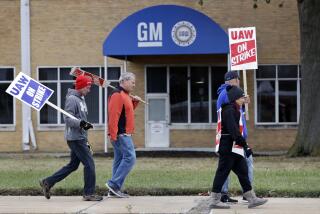Detroit Finally Is Thinking in the Long Term
Last year the Detroit automobile companies were offering low-interest financing, but this year it’s longer warranties. General Motors offers a six-year or 60,000-mile warranty on engine and transmission, and so does Ford. Chrysler, which already offered a five-year, 50,000-mile warranty, is now pushing it out to seven years or 70,000 miles.
What does it all mean? That--with allowances for the auto industry’s incredible ability to irritate its customers--somebody’s thinking competitively in Detroit.
On the face of it, of course, long warranties are a confidence-building approach to selling cars. Lee Iacocca used them in 1982 when Chrysler was still in extremis. Don’t be afraid to buy our cars, said Chrysler, in effect; we guarantee to fix them if they break. It was a declaration that Chrysler not only believed in its cars but believed in its own survival.
Now GM and Ford are declaring that they, too, believe in their products’ quality--although it is faith tempered with reservations. All three major U.S. car makers have a catch in their warranties. It says that after 12 months or 12,000 miles--what GM, Ford and Chrysler call the “basic warranty”--the companies will charge a $100 deductible for each repair visit. Why the $100? Obviously, because the car makers fear the program getting too expensive, which sounds like an admission that their quality improvement programs still have a ways to go.
Not Universal
Not all car makers charge deductibles, after all. Toyota, for example, offers a 36-month, 36,000-mile warranty without deductible. But then, Toyota seems to have less to worry about. Along with 11 other foreign car makers, it ranks above average in the quality-measuring index of consumer satisfaction compiled by J. D. Power & Associates, the auto research firm. None of Chrysler’s cars score above average on that index, and only Cadillac of General Motors’ cars makes an average score. Ford does better--with Lincoln and Mercury above average, and Ford right on average--but the predominance of foreign cars on the list is chilling.
Still, the Big Three’s warranty programs should not be dismissed as merely a nice try. The U.S. companies are standing behind their cars in that crucial period beyond 40,000-50,000 miles, when problems begin to develop. Giving such assurance to their customers has value--even if it is undoubtedly cheaper than last year’s low-rate car loans.
In any case, the warranty approach cannot be understood from its effect only on the customer. More important, it is a program designed to help the roughly 19,600 U.S. car dealers who are affiliated with GM, Ford or Chrysler. If low interest rates brought customers into dealers’ showrooms, warranties are intended to keep them coming back for service. And that means money in dealers’ cash drawers, because all work in service is profitable. One large operator in the Midwest, with Ford, GM and Chrysler dealerships in three states, estimates that he makes a 50% profit on the labor costs he bills for warranty work.
Acceptable Cost
Who pays? Detroit does, but it’s an acceptable cost because it helps support the dealer distribution system that is one of the real remaining advantages that U.S. manufacturers have against foreign competition.
And that’s important, because the next two to three years are going to be the most competitive in the automobile industry’s history. There are now about 30 car manufacturers fielding entries in the U.S. market, and more coming every day. Some foreign makers have their own dealer networks, others piggyback on a domestic dealer who, these days, may carry a variety of car nameplates. Car manufacturers in other words may soon be vying for floor space in the showroom the way cereal and soap makers battle for shelf space in the supermarket.
So the U.S. car makers are making it more attractive for dealers to sell the Detroit product by lending support to the service business. A strong service operation can bring in enough money to pay a dealership’s rent and light bills, thus leaving more room to maneuver on the car-selling side.
Service, in short, confers a competitive edge just at a time when an edge is most useful. The Big Three now have about 73% of all U.S. car sales, according to figures worked up by analyst Charles J. Brady for the research firm Sanford C. Bernstein & Co. By 1990, Brady reckons, that share may be down to around 61%--given all the imports new nations will be sending here and all the new cars the Japanese will produce in the United States.
The point is that the market will be a free-for-all, with some manufacturers, and dealers, unable to make a profit. But Detroit car makers are determined to get through that crunch profitably and to help their dealers to do the same. All things considered, it looks like somebody is thinking long term in Detroit these days.






